University Name: Poltergeist Analysis - Media and Technology's Impact
VerifiedAdded on 2022/08/09
|7
|1798
|56
Report
AI Summary
This report provides a detailed analysis of the 1982 horror film Poltergeist, examining its portrayal of media, particularly television, as a source of fear and anxiety within a suburban setting. The analysis explores how the film critiques the addictive influence of television and its potential to disrupt family life and societal norms. The report delves into key scenes, highlighting the symbolic role of television as a portal to the supernatural and a reflection of societal anxieties during the Reagan era. The essay draws on various critical perspectives to interpret the film's themes of technology, consumer culture, and the fragility of the suburban ideal. The conclusion emphasizes the film's lasting impact and its commentary on the impact of media on the lives of individuals and families. The analysis incorporates references to relevant academic sources to support the arguments presented.
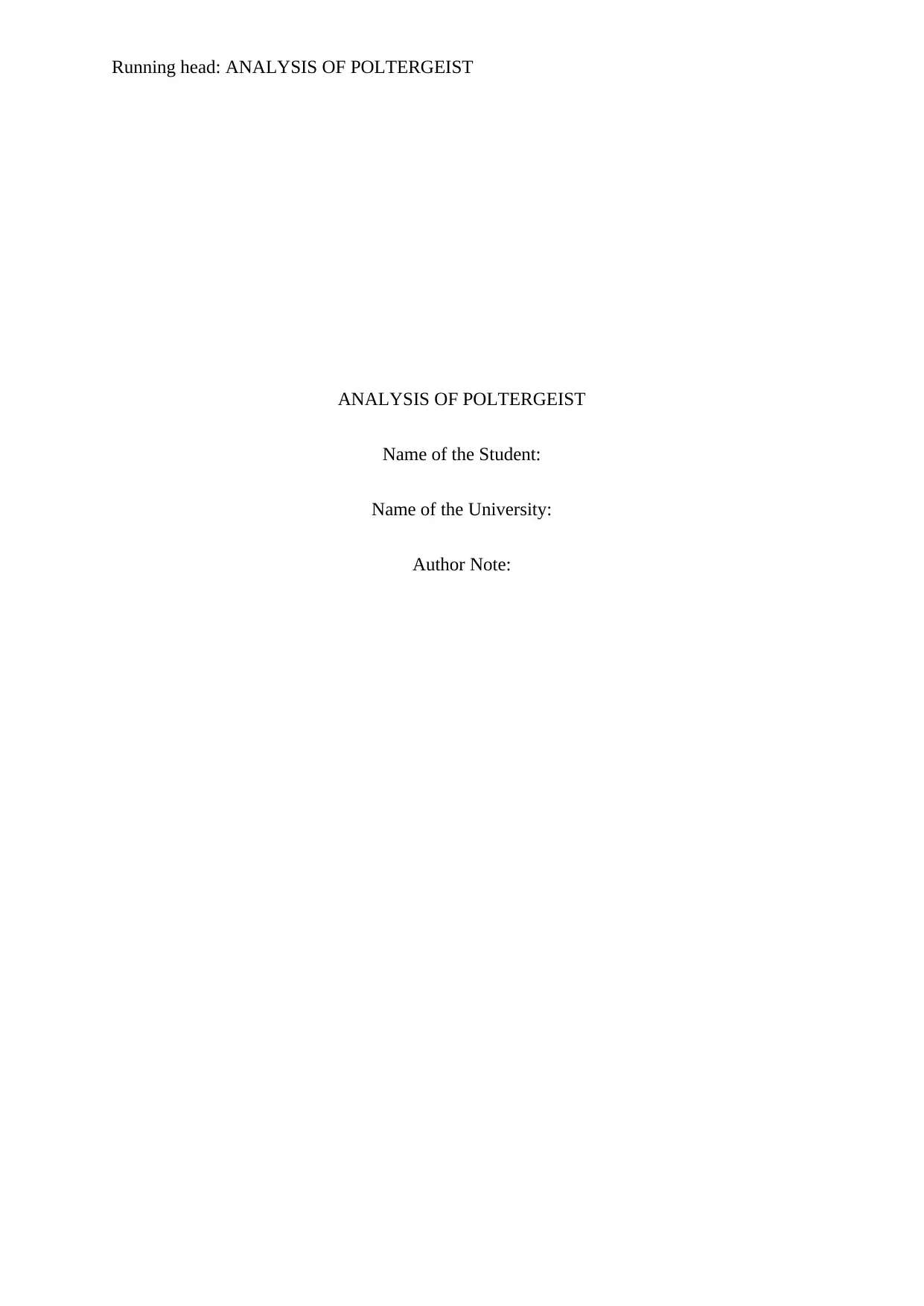
Running head: ANALYSIS OF POLTERGEIST
ANALYSIS OF POLTERGEIST
Name of the Student:
Name of the University:
Author Note:
ANALYSIS OF POLTERGEIST
Name of the Student:
Name of the University:
Author Note:
Paraphrase This Document
Need a fresh take? Get an instant paraphrase of this document with our AI Paraphraser
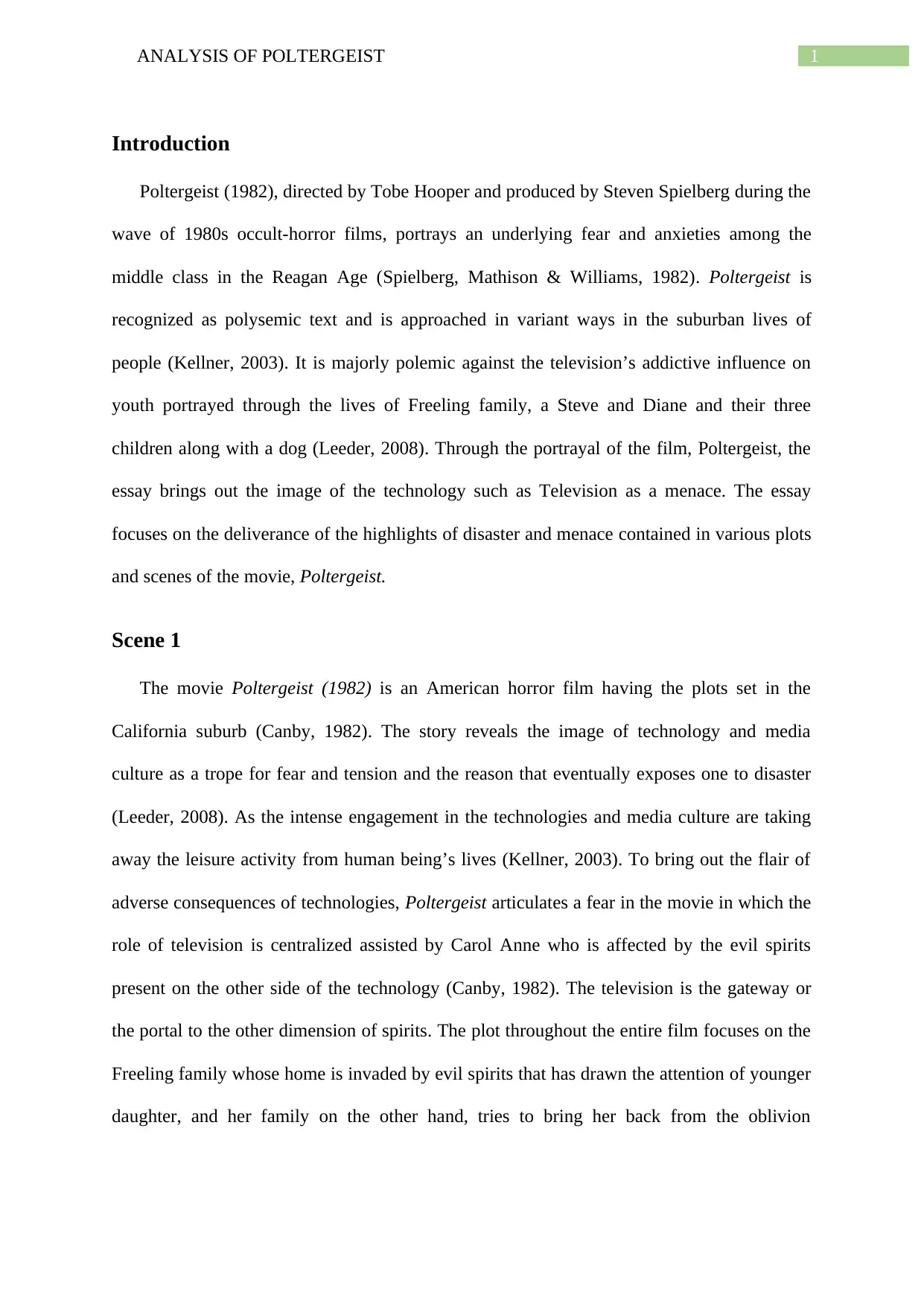
1ANALYSIS OF POLTERGEIST
Introduction
Poltergeist (1982), directed by Tobe Hooper and produced by Steven Spielberg during the
wave of 1980s occult-horror films, portrays an underlying fear and anxieties among the
middle class in the Reagan Age (Spielberg, Mathison & Williams, 1982). Poltergeist is
recognized as polysemic text and is approached in variant ways in the suburban lives of
people (Kellner, 2003). It is majorly polemic against the television’s addictive influence on
youth portrayed through the lives of Freeling family, a Steve and Diane and their three
children along with a dog (Leeder, 2008). Through the portrayal of the film, Poltergeist, the
essay brings out the image of the technology such as Television as a menace. The essay
focuses on the deliverance of the highlights of disaster and menace contained in various plots
and scenes of the movie, Poltergeist.
Scene 1
The movie Poltergeist (1982) is an American horror film having the plots set in the
California suburb (Canby, 1982). The story reveals the image of technology and media
culture as a trope for fear and tension and the reason that eventually exposes one to disaster
(Leeder, 2008). As the intense engagement in the technologies and media culture are taking
away the leisure activity from human being’s lives (Kellner, 2003). To bring out the flair of
adverse consequences of technologies, Poltergeist articulates a fear in the movie in which the
role of television is centralized assisted by Carol Anne who is affected by the evil spirits
present on the other side of the technology (Canby, 1982). The television is the gateway or
the portal to the other dimension of spirits. The plot throughout the entire film focuses on the
Freeling family whose home is invaded by evil spirits that has drawn the attention of younger
daughter, and her family on the other hand, tries to bring her back from the oblivion
Introduction
Poltergeist (1982), directed by Tobe Hooper and produced by Steven Spielberg during the
wave of 1980s occult-horror films, portrays an underlying fear and anxieties among the
middle class in the Reagan Age (Spielberg, Mathison & Williams, 1982). Poltergeist is
recognized as polysemic text and is approached in variant ways in the suburban lives of
people (Kellner, 2003). It is majorly polemic against the television’s addictive influence on
youth portrayed through the lives of Freeling family, a Steve and Diane and their three
children along with a dog (Leeder, 2008). Through the portrayal of the film, Poltergeist, the
essay brings out the image of the technology such as Television as a menace. The essay
focuses on the deliverance of the highlights of disaster and menace contained in various plots
and scenes of the movie, Poltergeist.
Scene 1
The movie Poltergeist (1982) is an American horror film having the plots set in the
California suburb (Canby, 1982). The story reveals the image of technology and media
culture as a trope for fear and tension and the reason that eventually exposes one to disaster
(Leeder, 2008). As the intense engagement in the technologies and media culture are taking
away the leisure activity from human being’s lives (Kellner, 2003). To bring out the flair of
adverse consequences of technologies, Poltergeist articulates a fear in the movie in which the
role of television is centralized assisted by Carol Anne who is affected by the evil spirits
present on the other side of the technology (Canby, 1982). The television is the gateway or
the portal to the other dimension of spirits. The plot throughout the entire film focuses on the
Freeling family whose home is invaded by evil spirits that has drawn the attention of younger
daughter, and her family on the other hand, tries to bring her back from the oblivion
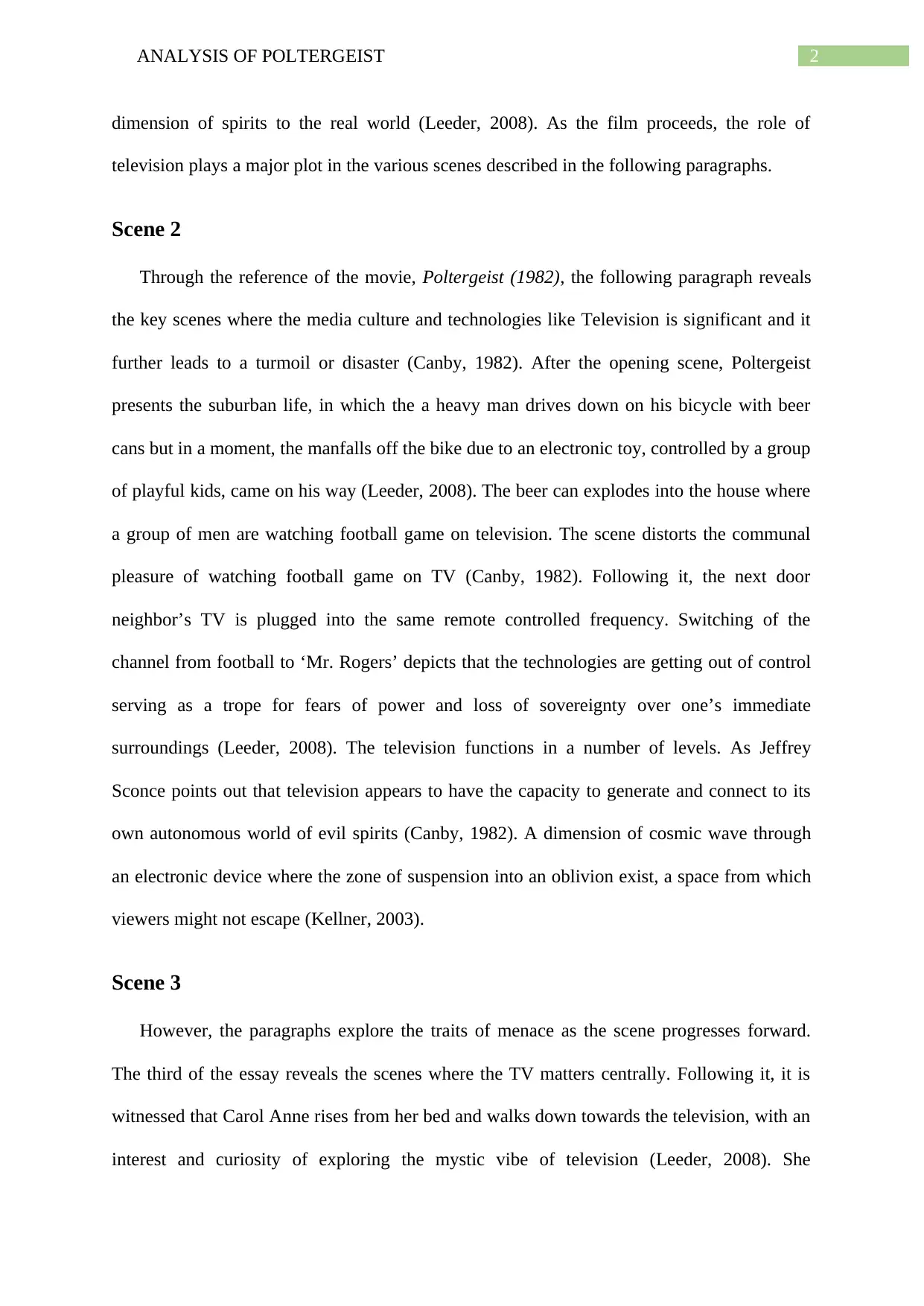
2ANALYSIS OF POLTERGEIST
dimension of spirits to the real world (Leeder, 2008). As the film proceeds, the role of
television plays a major plot in the various scenes described in the following paragraphs.
Scene 2
Through the reference of the movie, Poltergeist (1982), the following paragraph reveals
the key scenes where the media culture and technologies like Television is significant and it
further leads to a turmoil or disaster (Canby, 1982). After the opening scene, Poltergeist
presents the suburban life, in which the a heavy man drives down on his bicycle with beer
cans but in a moment, the manfalls off the bike due to an electronic toy, controlled by a group
of playful kids, came on his way (Leeder, 2008). The beer can explodes into the house where
a group of men are watching football game on television. The scene distorts the communal
pleasure of watching football game on TV (Canby, 1982). Following it, the next door
neighbor’s TV is plugged into the same remote controlled frequency. Switching of the
channel from football to ‘Mr. Rogers’ depicts that the technologies are getting out of control
serving as a trope for fears of power and loss of sovereignty over one’s immediate
surroundings (Leeder, 2008). The television functions in a number of levels. As Jeffrey
Sconce points out that television appears to have the capacity to generate and connect to its
own autonomous world of evil spirits (Canby, 1982). A dimension of cosmic wave through
an electronic device where the zone of suspension into an oblivion exist, a space from which
viewers might not escape (Kellner, 2003).
Scene 3
However, the paragraphs explore the traits of menace as the scene progresses forward.
The third of the essay reveals the scenes where the TV matters centrally. Following it, it is
witnessed that Carol Anne rises from her bed and walks down towards the television, with an
interest and curiosity of exploring the mystic vibe of television (Leeder, 2008). She
dimension of spirits to the real world (Leeder, 2008). As the film proceeds, the role of
television plays a major plot in the various scenes described in the following paragraphs.
Scene 2
Through the reference of the movie, Poltergeist (1982), the following paragraph reveals
the key scenes where the media culture and technologies like Television is significant and it
further leads to a turmoil or disaster (Canby, 1982). After the opening scene, Poltergeist
presents the suburban life, in which the a heavy man drives down on his bicycle with beer
cans but in a moment, the manfalls off the bike due to an electronic toy, controlled by a group
of playful kids, came on his way (Leeder, 2008). The beer can explodes into the house where
a group of men are watching football game on television. The scene distorts the communal
pleasure of watching football game on TV (Canby, 1982). Following it, the next door
neighbor’s TV is plugged into the same remote controlled frequency. Switching of the
channel from football to ‘Mr. Rogers’ depicts that the technologies are getting out of control
serving as a trope for fears of power and loss of sovereignty over one’s immediate
surroundings (Leeder, 2008). The television functions in a number of levels. As Jeffrey
Sconce points out that television appears to have the capacity to generate and connect to its
own autonomous world of evil spirits (Canby, 1982). A dimension of cosmic wave through
an electronic device where the zone of suspension into an oblivion exist, a space from which
viewers might not escape (Kellner, 2003).
Scene 3
However, the paragraphs explore the traits of menace as the scene progresses forward.
The third of the essay reveals the scenes where the TV matters centrally. Following it, it is
witnessed that Carol Anne rises from her bed and walks down towards the television, with an
interest and curiosity of exploring the mystic vibe of television (Leeder, 2008). She
⊘ This is a preview!⊘
Do you want full access?
Subscribe today to unlock all pages.

Trusted by 1+ million students worldwide
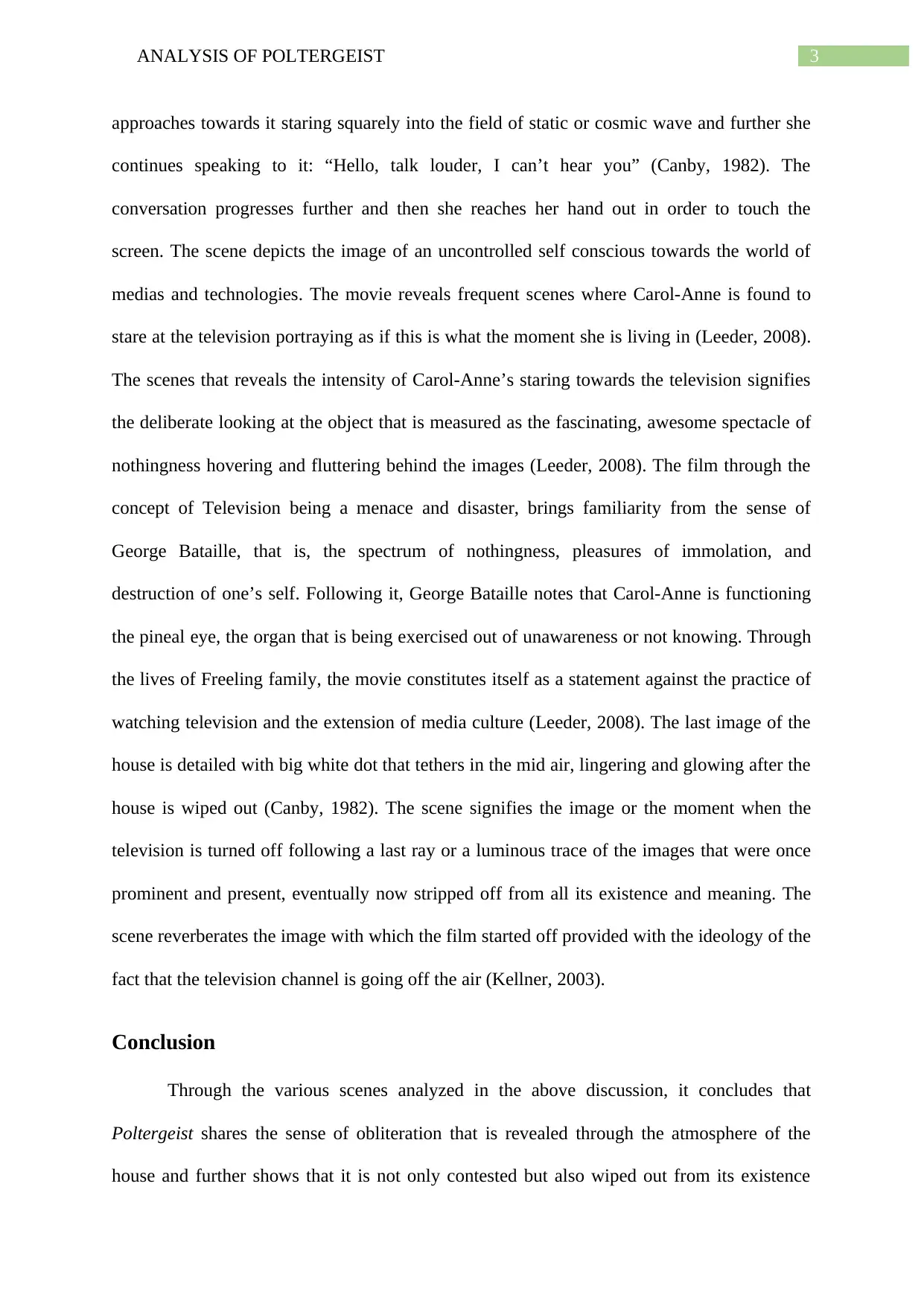
3ANALYSIS OF POLTERGEIST
approaches towards it staring squarely into the field of static or cosmic wave and further she
continues speaking to it: “Hello, talk louder, I can’t hear you” (Canby, 1982). The
conversation progresses further and then she reaches her hand out in order to touch the
screen. The scene depicts the image of an uncontrolled self conscious towards the world of
medias and technologies. The movie reveals frequent scenes where Carol-Anne is found to
stare at the television portraying as if this is what the moment she is living in (Leeder, 2008).
The scenes that reveals the intensity of Carol-Anne’s staring towards the television signifies
the deliberate looking at the object that is measured as the fascinating, awesome spectacle of
nothingness hovering and fluttering behind the images (Leeder, 2008). The film through the
concept of Television being a menace and disaster, brings familiarity from the sense of
George Bataille, that is, the spectrum of nothingness, pleasures of immolation, and
destruction of one’s self. Following it, George Bataille notes that Carol-Anne is functioning
the pineal eye, the organ that is being exercised out of unawareness or not knowing. Through
the lives of Freeling family, the movie constitutes itself as a statement against the practice of
watching television and the extension of media culture (Leeder, 2008). The last image of the
house is detailed with big white dot that tethers in the mid air, lingering and glowing after the
house is wiped out (Canby, 1982). The scene signifies the image or the moment when the
television is turned off following a last ray or a luminous trace of the images that were once
prominent and present, eventually now stripped off from all its existence and meaning. The
scene reverberates the image with which the film started off provided with the ideology of the
fact that the television channel is going off the air (Kellner, 2003).
Conclusion
Through the various scenes analyzed in the above discussion, it concludes that
Poltergeist shares the sense of obliteration that is revealed through the atmosphere of the
house and further shows that it is not only contested but also wiped out from its existence
approaches towards it staring squarely into the field of static or cosmic wave and further she
continues speaking to it: “Hello, talk louder, I can’t hear you” (Canby, 1982). The
conversation progresses further and then she reaches her hand out in order to touch the
screen. The scene depicts the image of an uncontrolled self conscious towards the world of
medias and technologies. The movie reveals frequent scenes where Carol-Anne is found to
stare at the television portraying as if this is what the moment she is living in (Leeder, 2008).
The scenes that reveals the intensity of Carol-Anne’s staring towards the television signifies
the deliberate looking at the object that is measured as the fascinating, awesome spectacle of
nothingness hovering and fluttering behind the images (Leeder, 2008). The film through the
concept of Television being a menace and disaster, brings familiarity from the sense of
George Bataille, that is, the spectrum of nothingness, pleasures of immolation, and
destruction of one’s self. Following it, George Bataille notes that Carol-Anne is functioning
the pineal eye, the organ that is being exercised out of unawareness or not knowing. Through
the lives of Freeling family, the movie constitutes itself as a statement against the practice of
watching television and the extension of media culture (Leeder, 2008). The last image of the
house is detailed with big white dot that tethers in the mid air, lingering and glowing after the
house is wiped out (Canby, 1982). The scene signifies the image or the moment when the
television is turned off following a last ray or a luminous trace of the images that were once
prominent and present, eventually now stripped off from all its existence and meaning. The
scene reverberates the image with which the film started off provided with the ideology of the
fact that the television channel is going off the air (Kellner, 2003).
Conclusion
Through the various scenes analyzed in the above discussion, it concludes that
Poltergeist shares the sense of obliteration that is revealed through the atmosphere of the
house and further shows that it is not only contested but also wiped out from its existence
Paraphrase This Document
Need a fresh take? Get an instant paraphrase of this document with our AI Paraphraser
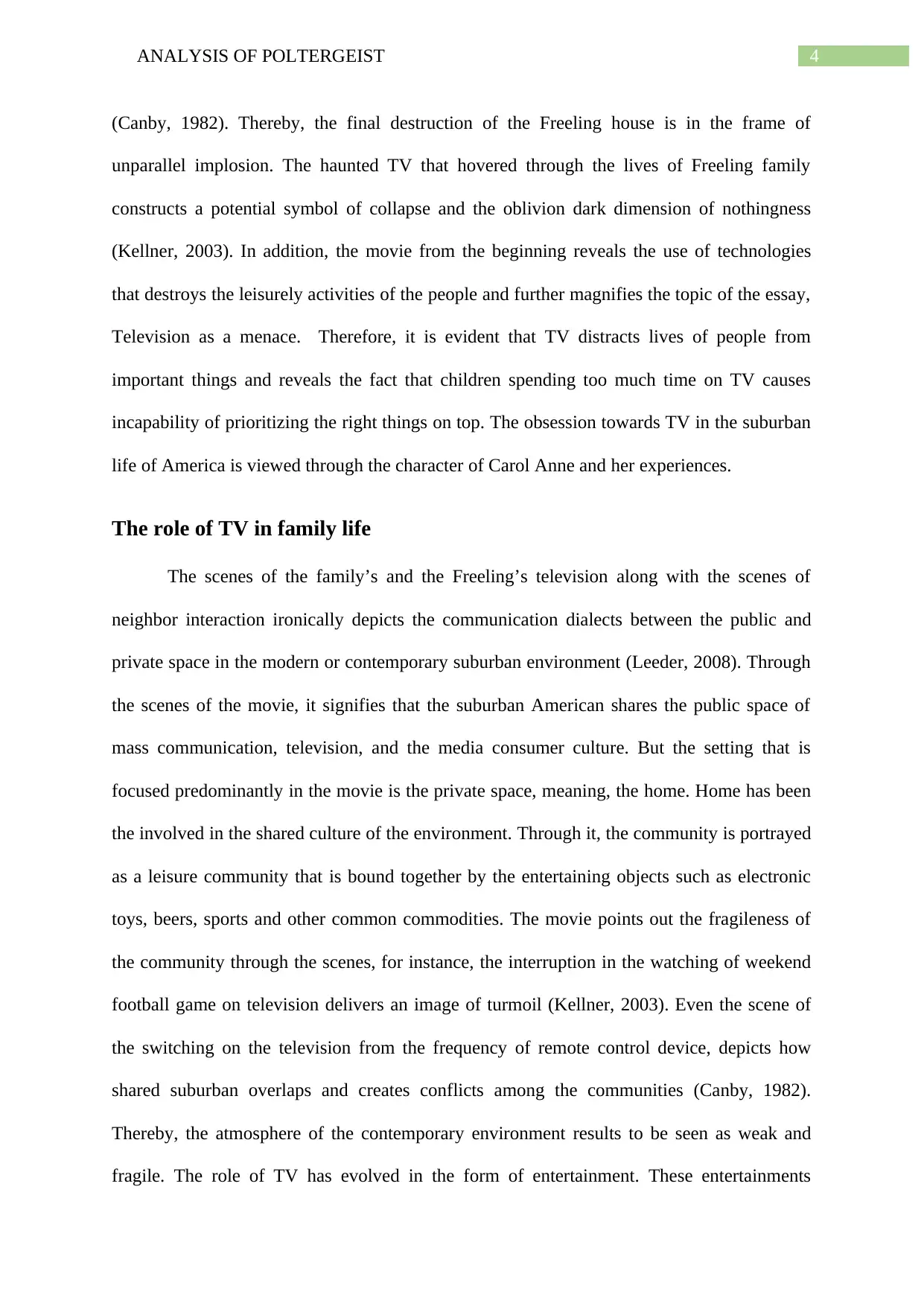
4ANALYSIS OF POLTERGEIST
(Canby, 1982). Thereby, the final destruction of the Freeling house is in the frame of
unparallel implosion. The haunted TV that hovered through the lives of Freeling family
constructs a potential symbol of collapse and the oblivion dark dimension of nothingness
(Kellner, 2003). In addition, the movie from the beginning reveals the use of technologies
that destroys the leisurely activities of the people and further magnifies the topic of the essay,
Television as a menace. Therefore, it is evident that TV distracts lives of people from
important things and reveals the fact that children spending too much time on TV causes
incapability of prioritizing the right things on top. The obsession towards TV in the suburban
life of America is viewed through the character of Carol Anne and her experiences.
The role of TV in family life
The scenes of the family’s and the Freeling’s television along with the scenes of
neighbor interaction ironically depicts the communication dialects between the public and
private space in the modern or contemporary suburban environment (Leeder, 2008). Through
the scenes of the movie, it signifies that the suburban American shares the public space of
mass communication, television, and the media consumer culture. But the setting that is
focused predominantly in the movie is the private space, meaning, the home. Home has been
the involved in the shared culture of the environment. Through it, the community is portrayed
as a leisure community that is bound together by the entertaining objects such as electronic
toys, beers, sports and other common commodities. The movie points out the fragileness of
the community through the scenes, for instance, the interruption in the watching of weekend
football game on television delivers an image of turmoil (Kellner, 2003). Even the scene of
the switching on the television from the frequency of remote control device, depicts how
shared suburban overlaps and creates conflicts among the communities (Canby, 1982).
Thereby, the atmosphere of the contemporary environment results to be seen as weak and
fragile. The role of TV has evolved in the form of entertainment. These entertainments
(Canby, 1982). Thereby, the final destruction of the Freeling house is in the frame of
unparallel implosion. The haunted TV that hovered through the lives of Freeling family
constructs a potential symbol of collapse and the oblivion dark dimension of nothingness
(Kellner, 2003). In addition, the movie from the beginning reveals the use of technologies
that destroys the leisurely activities of the people and further magnifies the topic of the essay,
Television as a menace. Therefore, it is evident that TV distracts lives of people from
important things and reveals the fact that children spending too much time on TV causes
incapability of prioritizing the right things on top. The obsession towards TV in the suburban
life of America is viewed through the character of Carol Anne and her experiences.
The role of TV in family life
The scenes of the family’s and the Freeling’s television along with the scenes of
neighbor interaction ironically depicts the communication dialects between the public and
private space in the modern or contemporary suburban environment (Leeder, 2008). Through
the scenes of the movie, it signifies that the suburban American shares the public space of
mass communication, television, and the media consumer culture. But the setting that is
focused predominantly in the movie is the private space, meaning, the home. Home has been
the involved in the shared culture of the environment. Through it, the community is portrayed
as a leisure community that is bound together by the entertaining objects such as electronic
toys, beers, sports and other common commodities. The movie points out the fragileness of
the community through the scenes, for instance, the interruption in the watching of weekend
football game on television delivers an image of turmoil (Kellner, 2003). Even the scene of
the switching on the television from the frequency of remote control device, depicts how
shared suburban overlaps and creates conflicts among the communities (Canby, 1982).
Thereby, the atmosphere of the contemporary environment results to be seen as weak and
fragile. The role of TV has evolved in the form of entertainment. These entertainments
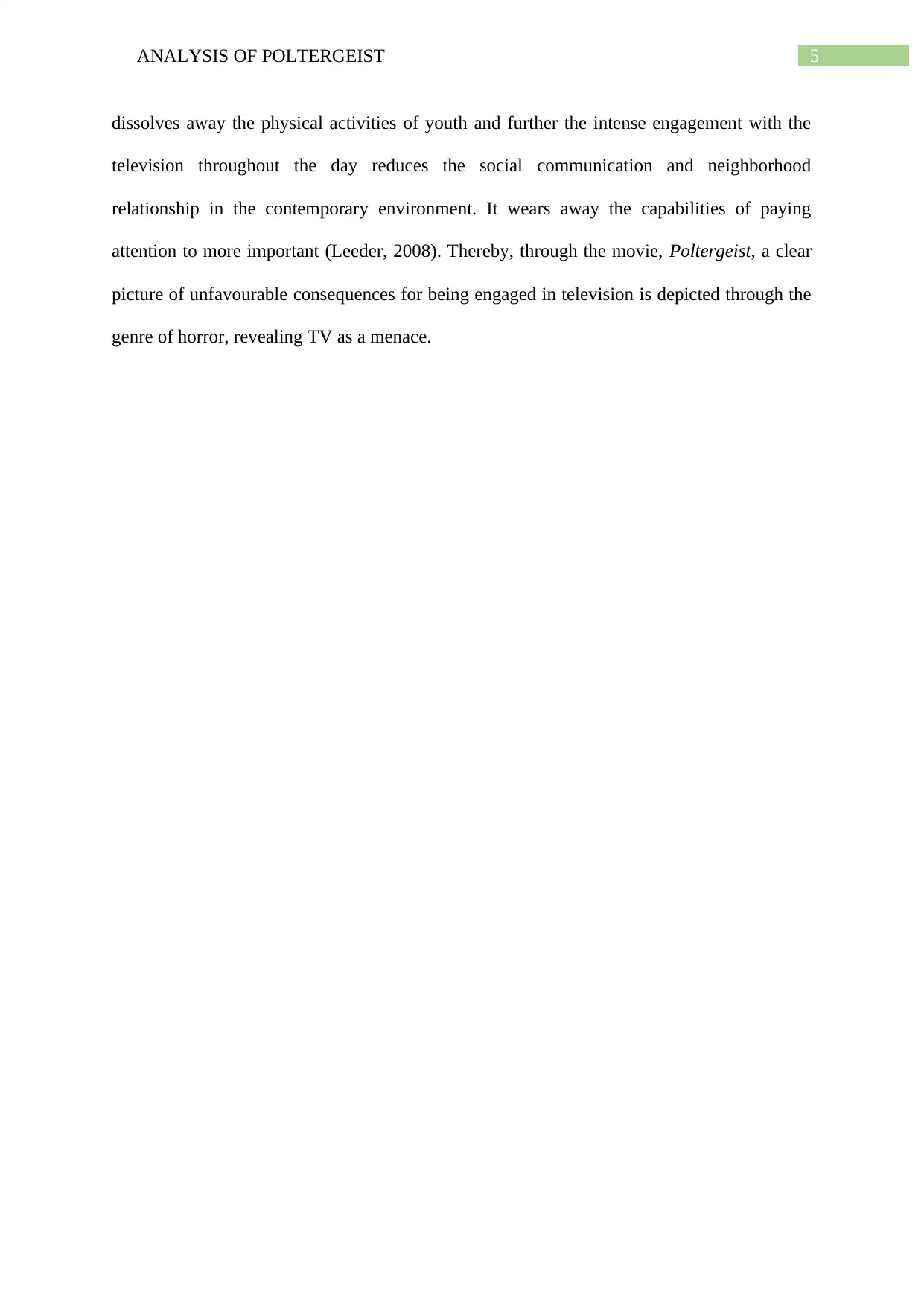
5ANALYSIS OF POLTERGEIST
dissolves away the physical activities of youth and further the intense engagement with the
television throughout the day reduces the social communication and neighborhood
relationship in the contemporary environment. It wears away the capabilities of paying
attention to more important (Leeder, 2008). Thereby, through the movie, Poltergeist, a clear
picture of unfavourable consequences for being engaged in television is depicted through the
genre of horror, revealing TV as a menace.
dissolves away the physical activities of youth and further the intense engagement with the
television throughout the day reduces the social communication and neighborhood
relationship in the contemporary environment. It wears away the capabilities of paying
attention to more important (Leeder, 2008). Thereby, through the movie, Poltergeist, a clear
picture of unfavourable consequences for being engaged in television is depicted through the
genre of horror, revealing TV as a menace.
⊘ This is a preview!⊘
Do you want full access?
Subscribe today to unlock all pages.

Trusted by 1+ million students worldwide
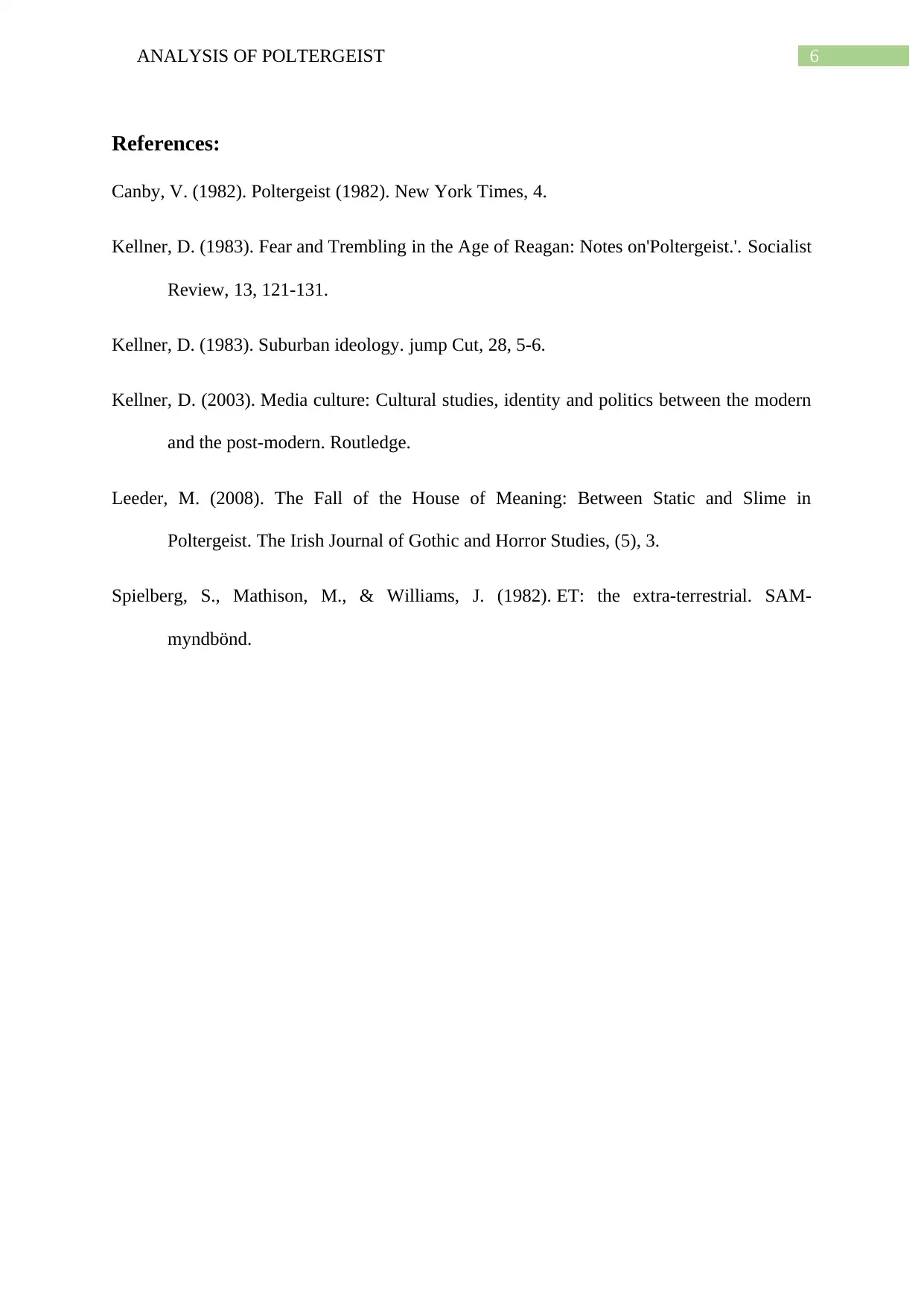
6ANALYSIS OF POLTERGEIST
References:
Canby, V. (1982). Poltergeist (1982). New York Times, 4.
Kellner, D. (1983). Fear and Trembling in the Age of Reagan: Notes on'Poltergeist.'. Socialist
Review, 13, 121-131.
Kellner, D. (1983). Suburban ideology. jump Cut, 28, 5-6.
Kellner, D. (2003). Media culture: Cultural studies, identity and politics between the modern
and the post-modern. Routledge.
Leeder, M. (2008). The Fall of the House of Meaning: Between Static and Slime in
Poltergeist. The Irish Journal of Gothic and Horror Studies, (5), 3.
Spielberg, S., Mathison, M., & Williams, J. (1982). ET: the extra-terrestrial. SAM-
myndbönd.
References:
Canby, V. (1982). Poltergeist (1982). New York Times, 4.
Kellner, D. (1983). Fear and Trembling in the Age of Reagan: Notes on'Poltergeist.'. Socialist
Review, 13, 121-131.
Kellner, D. (1983). Suburban ideology. jump Cut, 28, 5-6.
Kellner, D. (2003). Media culture: Cultural studies, identity and politics between the modern
and the post-modern. Routledge.
Leeder, M. (2008). The Fall of the House of Meaning: Between Static and Slime in
Poltergeist. The Irish Journal of Gothic and Horror Studies, (5), 3.
Spielberg, S., Mathison, M., & Williams, J. (1982). ET: the extra-terrestrial. SAM-
myndbönd.
1 out of 7
Your All-in-One AI-Powered Toolkit for Academic Success.
+13062052269
info@desklib.com
Available 24*7 on WhatsApp / Email
![[object Object]](/_next/static/media/star-bottom.7253800d.svg)
Unlock your academic potential
Copyright © 2020–2025 A2Z Services. All Rights Reserved. Developed and managed by ZUCOL.